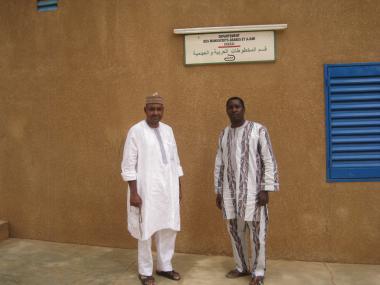Editorial, June 2014

Niamey. I am writing from the capital of Niger where I am spending time at the Université Abdou Moumouni de Niamey, which hosts the IRSH (Institut de Recherches en de Sciences Humaines). This Institute, in fact, is much older than the university having been established in 1940 already but was differently named then; the university only opened it doors to students well after independence, beginning in 1971. But IRSH is now very much a university research centre. The Institute is the location for a number of independent research units or departments and the one relevant to us is the Département des Manuscrits Arabes et Ajami (MARA) which holds a gradually increasing number of manuscripts. A collection of some four thousand manuscripts has already been fully described; details about them can be found in the Institute’s eight-volume catalogue published between 2004 and 2008 by Al-Furqan Foundation in London. The collection grows almost annually because of the missions to distant towns and settlements, which have private, family libraries. It is the only programme I believe which explicitly notes the Arabic and Ajami character of the manuscripts. The Ajami materials reflect the dominant languages in the region: Hausa, Zerma (eastern Songhay) and Tamashek. The Institute’s manuscript research is led by two well-known scholars in the field, Drs. Moulaye Hassane and Seyni Moumouni. They have a group eight researchers working with them. While the aims of the MARA are broadly what many similar units or programmes have this one is almost entirely focused on research using the materials in the collection. Thus the recent edition of a work by ‘Uthmān dan Fodio edited by Dr Seyni Moumouni and Salou El-Hassan is based on a copy of a manuscript in the collection (of course, compared against other copies of the work).* No conservation facility exists. Yet many manuscripts I worked with are in dire need of conservation.


Niamey is in the southwest of the country and it is only about 450 km from Gao, Mali. In other words a day’s driving could get one to Gao. This of course is out of the question at the moment given the insecurities in northern Mali since 2012. But what it does point to is the significance of the history of Gao and the Songhay state (c.1450-1591) in this country, at least in this part of the country. The Songhay past as a past with knowable and roughly datable characters and political power and influence certainly appears to be very much alive in this part of Niger. Thus I saw in the daily register in the MARA reading room that there is a local university called Université de Mahmoud Kati, which is a private institution and started classes this year. Mahmoud Kati (d.1593) of course refers to the alleged author of one of the famous chronicles of Timbuktu, the Ta’rīkh al-Fattāsh. The connection to the centres of Songhay power is therefore more than academic. In any case, from a research perspective, the IRSH manuscript collection contains numerous items – originals and copies, and copies of copies – that are connected to Timbuktu and Gao.

This connection across space of the documents and texts reminds one again of the newness – and near futility – of the borders of the African states. Older states and “empires”; long-trodden trade routes and pilgrimage paths; these all in actuality and in potentiality linked places and peoples and ideas over wide expanses. Names and works of Timbuktu scholars were known even further south in Kano and beyond, for instance. And likewise, there was an interest in Timbuktu in the works produced in what is today northern Nigeria.

Tombouctou Mss Project developments over last few months: Dr. Mauro Nobili and Susana Molins Lliteras went to Mali in second part of 2013. They visited the Timbuktu libraries relocated to Bamako and took stock of the new situation, its challenges and priorities. After their return, we hosted Dr Abdoulkadir Maiga, Director of the IHERIAB (Institut des Hautes Etudes et de Recherches Islamiques- Ahmed Baba) in November 2013. He presented a seminar entitled “Update on the situation in Timbuktu and Mali” in which he provided first hand information on the transfer of the manuscripts to Bamako and their current state. Also at the end of November, we hosted Dr. Elemine Moustapha from the Department of History at the University of Nouakchott who presented a seminar entitled “The Contemporary Mauritanian Crisis.”

At the beginning of 2014 we received the good news that we have been granted funding for two years from the Gerda Henkel Stiftung in order to support the ongoing activities of the project. This funding allows us to continue our research exchange with scholars from Mali and the continent, as well as supporting students engaging in research on African manuscripts.
We are currently hosting Dr. Mohamed Diagayété and Sidi Allimam Maiga from IHERIAB for a period of five weeks. They report that there is a slow movement of people and basic services back to Timbuktu; the Ahmad Baba Institute’s administration is certainly back up and running. However, just in the last few days, renewed fighting and casualties in Kidal led to the closure of banks in Timbuktu on Thursday 22 May; bringing back memories of April 2012 when the banks closed just a few days before the rebel take-over. Although the banks reopened on Saturday, this incident reflects the volatility and precariousness of the situation in Northern Mali.
Shamil Jeppie
*Seyni Moumouni et Salou El-Hassan (eds.), Inspiration spirituelle et élaboration des sciences ésotériques et exotériques de ‘Uthmān dan Fodio. Vecmas (Valorisation et Edition Critique des Manuscrits Arabes Sub-Sahariens (Lyon: ENS Editions, 2012). Critical edition of Fath al-basā’ir li-taḥqīq wad‘ ‘ulūm al-bawātin wa al-dhawāhir.